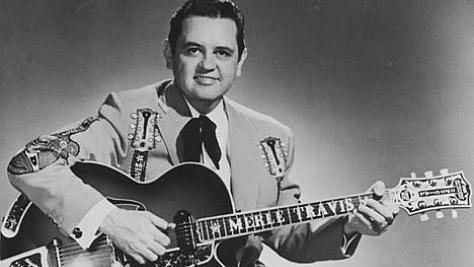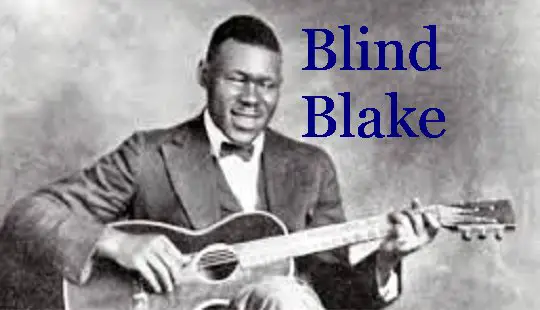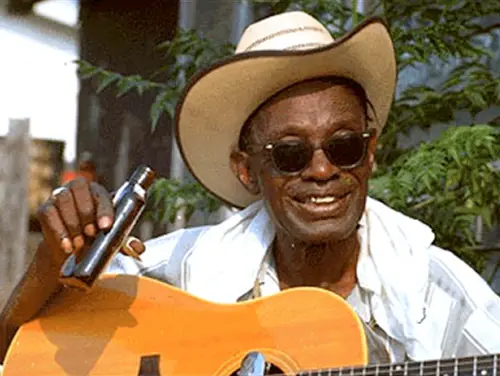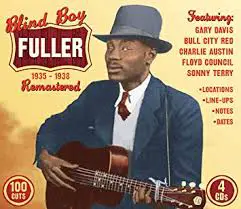Beginning Fingerstyle Blues Guitar - The Two Basic Fingerstyle Patterns
The big difference between the basic patterns used in
fingerstyle acoustic blues guitar is how the thumb moves. Take a look at the many Youtube videos of the old blues guys, such as Big Bill Broonzy, Lightnin' Hopkins, Blind Blake and Reverend Gary Davis and you should quickly get the idea that the thumb is King! Of course, the fingers do some fancy stuff and create unforgettable melodies, but without that solid and inventive picking thumb, it all falls apart.
It's a big mistake to skimp on basic thumb training - it needs to become almost completely independent of the fingers, so that it can move anywhere and pick any string at will. Maybe the best way to check out the different style is to look at some master blues pickers and how they did their stuff.
All blues fingerpickers have a style that fits into one of two broad categories, although many guitarists do mix up the two styles in their songs.
The Monotonic Bass Blues Fingerpicking Pattern
Any fingerstyle blues guitar lessons should really cover the very roots of acoustic blues, which probably originated in the Mississippi Delta after the end of slavery. This style tended to be more basic than later picking patterns, and the main characteristic was how the thumb moved. Basically, it tended to strike just one string, or two, without moving between two or three in a regular fashion.
Many blues men tended to move to a different bass string when changing to another chord, but this wasn't always the case either! Some players, such as Big Bill Broonzy and Mance Lipscombe in particular, didn't even bother to change to a different bass string, they just muted the note with their hand.
If you look at the picking hand of an accomplished fingerstyle guitar player, you notice that the heel of the hand is either resting on the bridge of the guitar, or very close to it.
 If the heel or palm of the hand is dropped onto the bass string just after it is struck, you don't get a note but more of a 'thunk' a bit like a drum beat.
If the heel or palm of the hand is dropped onto the bass string just after it is struck, you don't get a note but more of a 'thunk' a bit like a drum beat.
It's OK to let the note ring when it fits the chord that's being fretted, but if the note is not included in the chord structure, and it sounds discordant, then the note is choked off with the hand.
This technique has a couple of advantages. First off, it provides a solid beat a little like a drum, which accentuates the sound and provides stability. Secondly, it allows for a lot of flexibility for the finger work - if you don't need to worry so much about what the thumb needs to do, the fingers can be more inventive with the melody.
Many acoustic fingerstyle blues players use a big plastic thumb pick to amplify this sound and produce some very exciting music. Other pages such as Broonzy, made this big thumb sound with his bare thumb, and late on we'll discuss the merits of using bare fingers or picks.
Blues fingerstyle tabs don't always show this bass string muted, but rather just demonstrate how it's done and perhaps mention it at the beginning of the tab. It's really up to the student to listen to the old players, and also use some common sense - if it doesn't sound good - mute it!
Alternating The Basses When Fingerpicking Blues Guitar
If you take a look at the section of fingerstyle blues tab below and you can see that the thumb is moving between three bass strings:
Holding down a basic C chord and starting with the B string, the thumb simply set up a steady rhythm repeating the pattern as long as we remain on the C. Of course, if we change chord, we (may) need to change the string or the order. ZAs with the monotonic bass style of picking, the palm can be dropped onto the strings if we need to mute the sound at any time.
In Practice, we also use the left hand finger to damp as well, so damping, or muting, becomes a function of both hands, depending on the song and the chord we use.
To be fair, it's this second style of thumb technique that really opened up the possibilities and allows for super syncopated arrangements to be created, as the thumb can create it's own melody, either augmenting the melody created by the fingers or by playing something completely different (within reason!)
 The method itself became known as Travis picking, named after Merle Travis, who used just his thumb and forefinger to make incredibly lovely guitar sounds.
The method itself became known as Travis picking, named after Merle Travis, who used just his thumb and forefinger to make incredibly lovely guitar sounds.
The secret to it all is that solid alternating thumb rhythm, which need to be the corner stone of any fingerstyle blues lessons.
Although the technique has it's origins in roots of acoustic blues, it has been employed effectively by artists such as Bob Dylan, Tom Paxton, Joan Baez, Simon and Garfunkel, Peter, Paul and Mary, and many others.
Before we leave our discussion about the alternating bass fingerpicking style it's worth taking a look at how one the early ragtime blues players, Blind Blake took the form and syncopate the movements to a whole new level that hasn't really been beat or even copied properly to this day.
Take a look at the fingerpicking blues tab section below, and particularly what's happening with the basses. We are using the C chord once again:
Once again we start on the B string, but Bake slips, or rolls, the thumb onto the G string producing two notes to the beat - 'bum-bum'. He does the same thing from the E string to the B, plays the next one straight (the G string) and then rolls that thumb again to complete the sequence.
Try it very slowly at first until you can do it with a good rhythm, and then gradually speed it up.
Of course, this is only one part of the story. In the MP3 clip below you can hear how he uses the thumb roll fingerpicking technique in his famous piece 'West Coast Blues'.
Listen how the basses and trebles act together to produce an incredibly complex sound that just makes your feet tap! It takes a huge amount of practice to get to this level, but it can be done with the right fingerpicking blues tabs. The trick is to start really slow and build up speed over a period of months.









